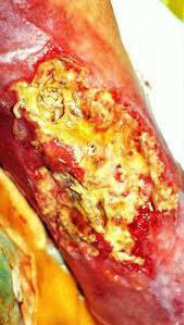
Description
An exudate fluid that filters from the circulatory system into lesions or areas of inflammation. Pus consists of a thin, protein-rich fluid, known as liquor puris, and dead leukocytes from the body's immune response (mostly neutrophils). An accumulation of pus in an enclosed tissue space is known as an abscess, whereas a visible collection of pus within or beneath the epidermis is known as a pustule or pimple.
Function
During infection, macrophages release cytokines which trigger neutrophils to seek the site of infection by chemotaxis. There, the neutrophils engulf and destroy the bacteria and the bacteria resist the immune response by releasing toxins called leukocidins. As the neutrophils die off from toxins and old age, they are destroyed by macrophages, forming the viscous pus.
Color
Typically white-yellow, yellow, or yellow-brown. Occasionally with blood.
Shape
Thick liquid that fills a cavity.
Location
Anywhere in body.
An exudate fluid that filters from the circulatory system into lesions or areas of inflammation. Pus consists of a thin, protein-rich fluid, known as liquor puris, and dead leukocytes from the body's immune response (mostly neutrophils). An accumulation of pus in an enclosed tissue space is known as an abscess, whereas a visible collection of pus within or beneath the epidermis is known as a pustule or pimple.
Function
During infection, macrophages release cytokines which trigger neutrophils to seek the site of infection by chemotaxis. There, the neutrophils engulf and destroy the bacteria and the bacteria resist the immune response by releasing toxins called leukocidins. As the neutrophils die off from toxins and old age, they are destroyed by macrophages, forming the viscous pus.
Color
Typically white-yellow, yellow, or yellow-brown. Occasionally with blood.
Shape
Thick liquid that fills a cavity.
Location
Anywhere in body.
 RSS Feed
RSS Feed
